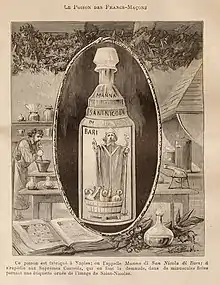Aqua Tofana
Aqua Tofana (also known as Acqua Toffana and Aqua Tufania and Manna di San Nicola) was a strong poison created in Sicily around 1630[1] that was reputedly widely used in Palermo, Naples,[2] Perugia, and Rome, Italy. It has been associated with Giulia Tofana, or Tofania, a woman from Palermo, purportedly the leader of a ring of six poisoners in Rome, who sold Aqua Tofana to would-be widows.

Original creation
The first recorded mention of Aqua Tofana is from 1632–33,[3][1] when it was used by two women, Francesca la Sarda and Teofania di Adamo, to poison their victims. It may have been invented by, and named after, Teofania.[1] She was executed for her crimes, but several women associated with her including Giulia Tofana (who may have been her daughter) and Gironima Spana moved on to Rome and continued manufacturing and distributing the poison.[1]
The 'tradename' "Manna di San Nicola" ("Manna of St. Nicholas of Bari") may have been a marketing device intended to divert the authorities, given that the poison was openly sold both as a cosmetic and a devotionary object in vials that included a picture of St. Nicholas. Over 600 victims[2] are alleged to have died from this poison, mostly husbands.
Between 1666 and 1676 the Marchioness de Brinvilliers poisoned her father and two brothers, amongst others, and she was executed on July 16, 1676.[4]
Ingredients
The active ingredients of the mixture are known, but not how they were blended. Aqua Tofana contained mostly arsenic and lead, and possibly belladonna. It was a colorless, tasteless liquid and therefore easily mixed with water or wine to be served during meals.
Symptoms
Poisoning by Aqua Tofana could go unnoticed, as the substance is clear and has no taste. It is slow acting, with symptoms resembling progressive disease or other natural causes. The symptoms seen are similar to the effects of arsenic poisoning. Those poisoned by Aqua Tofana reported several symptoms. The first small dosage would produce cold-like symptoms. The victim was very ill by the third dose; symptoms included vomiting, dehydration, diarrhea, and a burning sensation in the digestive system. The fourth dose would kill the victim. As it was slow acting, it allowed victims time to prepare for their death, including writing a will and repenting. The antidote often given was vinegar and lemon juice.[5][6]
Legend about Mozart
The legend that Wolfgang Amadeus Mozart (1756–1791) was poisoned using Aqua Tofana[7] is completely unsubstantiated, even though it was Mozart himself who started this rumor.[8]
References
- Philip Wexler, Toxicology in the Middle Ages and Renaissance, Elsevier Science - 2017, pages 63-64
- Stuart, David C. (2004). Dangerous Garden. Harvard University Press. p. 118. ISBN 9780674011045.
La Toffana....aqua Toffana
- Dash, Mike. "Aqua Tofana". academia.edu. Retrieved February 24, 2017.
- Vincent, Benjamin (1863). Dictionary of Dates. London: Edward Moxon & Co.
- Dash, Mike (2017). "Chapter 6 - Aqua Tofana". In Wexler, Philip (ed.). Toxicology in the Middle Ages and Renaissance. Academic Press. pp. 63–69. ISBN 9780128095546.
- "Aqua Tofana: slow-poisoning and husband-killing in 17th century Italy". A Blast From The Past. 6 April 2015.
- Chorley, Henry Fothergill. 1854. Modern German Music: Recollections and Criticisms. London: Smith, Elder & Co., p. 193.
- Robbins Landon, H. C., 1791: Mozart's Last Year, Schirmer Books, New York (1988), pp. 148 ff.
External links
- Definition at thefreedictionary.com
- Definition at infoplease.com